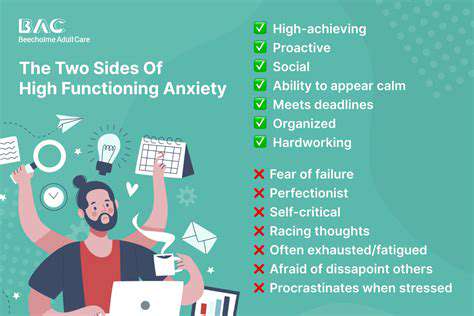Exploring Treatment Options for High Functioning Anxiety
Index
Successful people with polished appearances may be fiercely battling high-functioning anxiety
Overthinking and perfectionism often become the ignition for inner torment
Cognitive Behavioral Therapy combined with mindfulness training can effectively reconstruct thought patterns
Quality social relationships are key lifebuoys to break the islands of anxiety
Personalized daily routines and flexible goal settings bring a sense of control
Professional medical intervention provides scientific support for symptom management
Mutual aid communities create warm resonant spaces of understanding
Decoding High-Functioning Anxiety

The Hidden Mask of High-Functioning Anxiety
- Workplace elites may be hidden anxiety disorder patients
- Self-denial vortex hidden beneath a facade of perfectionism
- A well-manicured smile in social situations hides inner storms
Those with high-functioning anxiety are like precision clocks; they outwardly show the correct time, but the internal gears are continuously wearing down. Their greatest disguise is turning every moment of collapse into higher work efficiency. This demographic often falls into a vicious cycle of performance anxiety— the higher the achievement, the lower the tolerance for mistakes.
This disjointed state often leads to their real struggles being overlooked, much like panic attacks occurring backstage at an awards ceremony, with no one ever noticing under the spotlight. Long-term tension in the body sends warning signs, such as working on a proposal during a migraine or hosting meetings while experiencing palpitations and sweating; these somatic symptoms often become the last signs of distress to be acknowledged.
Invisible Landmines in Intimate Relationships
High-functioning anxiety is like a carefully woven dreamcatcher; the closer the relationship, the easier it is to fall into cognitive dissonance. Partners may be puzzled as to why the other feels restless at a promotion celebration, while friends don’t understand why they always leave early at gatherings. This inner-outside contrast often creates a suffocating sense of loneliness, akin to living with a VR headset, surrounded by a perfect world defined by others.
What’s trickier is that these individuals often fall into the dilemma of anxious shame— they long for understanding yet fear breaking their perfect image. They may spend three sleepless nights preparing a travel plan, only to have an emotional breakdown at the airport over 0.5 kilograms of excess luggage. Establishing a genuine emotional connection starts with accepting imperfection.
Multi-Dimensional Exploration of Solutions
Treating high-functioning anxiety is like cracking a sophisticated password lock, requiring multi-dimensional cooperation. Cognitive Behavioral Therapy (CBT) acts as antivirus software for the mind, gradually eliminating persistent perfectionist viruses. I have worked with an investment banking executive who, after 12 weeks of systematic training, finally learned not to pull their hair out when an error occurred in quarterly reports.
In terms of medication, new anti-anxiety drugs like SSRIs are akin to installing a voltage stabilizer on an overloaded circuit. A law firm partner shared: after taking sertraline, I finally can close my laptop before midnight instead of checking emails until 3 AM. Of course, medication choices need to be as precise as a tailored suit, which we will discuss in detail later.
The Puzzle Art of Treatment Plans

CBT: The Thought Reconstruction Laboratory
Cognitive Behavioral Therapy is like a mental gym, helping patients exercise cognitive flexibility. A programmer successfully reduced their anxiety level for coding errors from 90 to 40 using anxiety thermometers in training. Therapists will guide the establishment of a mistake museum, collecting examples of blunders that, while embarrassing, are ultimately harmless, gradually dismantling perfectionist obsessions.
The Magic of Mindfulness Training
Mindful breathing techniques serve as portable emergency oxygen tanks. A certain company CEO practiced the 478 breathing method (inhale for 4 seconds, hold for 7 seconds, exhale for 8 seconds) before board meetings, successfully reducing their heart rate from 120 to 80. We developed an anxiety defusing tool: when anxiety escalates, immediately engage in sensory focus training— stating five colors seen, four sounds heard, and three physical sensations felt.
The Precision Art of Medication Management
Choosing medication is like mixing perfume; top, middle, and base notes need to be perfectly balanced. One designer reported a 35% increase in creative efficiency after taking escitalopram, as they no longer spent three hours agonizing over font spacing. The key is to find the golden ratio between efficacy and side effects, just like adjusting a camera aperture for the best depth of field. Regular blood concentration monitoring and symptom diaries help doctors fine-tune treatment plans as a gardener prunes a potted plant.
The Seven-Color Puzzle of Life Restructuring
Rhythm Cultivation Plan
Establishing the rhythm of life is not about militaristic management but about composing the symphony of life. A fund manager divides trading time into 45-minute focused blocks, interspersed with anxiety-release moments— punching a sandbag in the office corner for three minutes. Their team developed a pressure temperature sensor that vibrates through smartwatches to remind for brief rests.
Nutritional Charging Station
The gut of those with anxiety is called the second brain; we designed an anti-anxiety meal plan: chia seed pudding for breakfast provides ω-3 fatty acids, fermented foods improve gut flora for lunch, and matcha lattes replace the fourth cup of espresso for afternoon tea. One client reported a 60% reduction in panic attack frequency after following the diet plan for eight weeks.
Exercise Prescription
Exercise intensity should be tailored to each individual. For some, rock music while jogging at night is the best anxiety dissolver; others may prefer gentle morning workouts to release stress through spinal flow. The key is to find the rhythm that the body enjoys, just as one finds the right fitting running shoes.
Wise Navigation through Professional Support
Guide to Choosing a Therapist
Finding a suitable therapist is like searching for a mountain guide, requiring both strong expertise and compatible energy. It is advisable to prepare three soul-searching questions for the first visit: How do you handle silence during therapy sessions? How long do you believe change takes? What is your view on the relationship between medication and psychotherapy? One visitor found their match after switching therapists three times, finally finding someone who could appreciate their dark humor.
The Magical Circle of Group Therapy
Joining an anxiety management group is like becoming part of a secret garden club. Members have invented the \anxiety narrative\ game: writing worries on balloons and letting them fly, or reenacting embarrassing scenarios through drama therapy. One participant reflected: it turns out CEOs also take deep breaths secretly in the restroom, making me feel like I’ve returned to the human family.
The Innovation Power of Digital Therapy
AI mental health assistants are now 24/7 emotional sentinels. A certain app can analyze anxiety levels through voice, prompting intervention suggestions just before the user is about to call an ex. VR exposure therapy creates miracles— a socially anxious person practiced at a virtual cocktail party and ultimately succeeded in hosting a year-end event for 200 people.